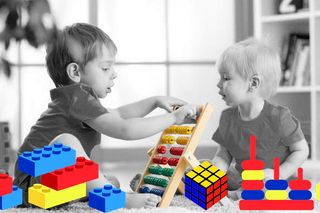
Closing the STEM Gender Gap, One Toy at a Time
All around the world, to varying degrees, STEM education and careers are disproportionately male. As girls and women advance through math and science education and professions, fewer and fewer remain. The sexist id...

All around the world, to varying degrees, STEM education and careers are disproportionately male. As girls and women advance through math and science education and professions, fewer and fewer remain. The sexist idea that women aren’t suited to these fields has long been debunked, and yet the gender gap remains unsolved. We know it starts early. We don’t necessarily know what to do.
New research suggests the gap starts even earlier than we think — before kids are school-aged, when they learn best through play. Childhood play experiences strongly shape a person’s spatial skills, according to a new study — the exact same skills critical to success in fields like science and engineering. Young adults who had played with construction-based toys such as Legos outperformed other peers in tests of spatial reasoning — like the ability to mentally rotate objects.
Most notably, the new research found that any gender differences in spatial skills disappear when the researchers considered the impact of childhood play.
“The human brain is malleable and trainable,” said Anne Gold, lead author and director of education and outreach at the Cooperative Institute for Research in Environmental Sciences. “By providing spatial training to K-12 children, and providing spatially demanding toys before schooling starts, we can give them the opportunity to develop skills important in fields like science, technology, engineering and math.”
Gold’s team gave written tests to more than 300 undergraduate students, tests that included multiple-choice questions that required them to mentally rotate obscure shapes, for example, or visualize an object’s cross section, finding a huge spectrum of spatial ability — students scored between 6% and 75% correct responses.
“All of these students completed a K-12 education. If spatial skills were taught in grade school, we wouldn’t see this significant spread of skills across the university classroom,” said Gold. “Something must be happening earlier in childhood or outside of school that makes some kids better spatial thinkers.”
The researchers then dissected the influence of several factors on spatial skills scores, including: college major, childhood play patterns, standardized test scores, number of science courses taken, and gender. They found that childhood play patterns made a huge difference:
Spatial skill scores were significantly higher among students who engaged with construction-based toys, and certain video games. This is not a new discovery — other studies have shown the influence of childhood play on spatial skills — but Gold’s team is the first to show how the gender gap well described in the literature is mediated through childhood play: While overall, male students performed better than female students on the test, the young women and men who played with construction-based toys and spatially demanding video games performed equally well.
In other words, when researchers controlled for the impact of childhood play patterns, gender differences disappeared.
This is a delightfully simple solution to a problem that has long dogged STEM fields and stymied not only women’s advancement but scientific advancement overall. In 2016, a UNESCO Asia-Pacific education brief on the STEM gender gap noted that “there is a global ‘talent shortage’ of 38 per cent, with the top ten hardest jobs to fill including a number of STEM-related professions. At the same time, the UNESCO Institute for Statistics (UIS) estimates that women make up just 28 per cent of scientific researchers worldwide.”
The result is a vast gap in human knowledge, a blank space that includes much of the female experience, highlighted by Lili Loofbourow in a recent article for The Week:
“… what about how our society’s scientific community has treated female dyspareunia — the severe physical pain some women experience during sex — vs. erectile dysfunction (which, while lamentable, is not painful)? PubMed has 393 clinical trials studying dyspareunia. Vaginismus? 10. Vulvodynia? 43.
Erectile dysfunction? 1,954.
That’s right: PubMed has almost five times as many clinical trials on male sexual pleasure as it has on female sexual pain.”
Giving a little girl building blocks instead of a doll might not solve this overnight. But if Gold’s research is anything to go by, it’s a pretty good place to start.
Related:
Related


The Buzz Cut: The Hadid Sisters Are Really Close
